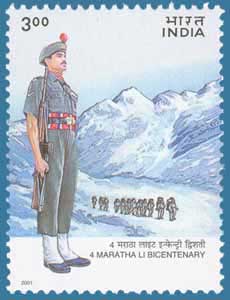
4 MARATHA LIGHT INFANTRY BICENTENARY

The Maratha Light Infantry is one of the oldest regiments of the Indian Army, famous for exploits and achievements that have examplified the meaning of duty, honour and courage.
Formed as the 103rd Maharattas in 1768, the Regimental Group was awarded the title of 'Light Infantry' in 1922. Light Infantry was a corps d'elite, a special honour bestowed for proven merit. Lightly armed and equipped for speedy movement, their capabilities for swift reconnaissance, and outflanking movements as well as counter-guerilla action were widely recognised.
The present 4* Battalion of the Maratha Light Infantry had its origin in the 2nd Battalion 8"1 Regiment raised in Mangalore in 1800. The fighting spirit, steadfastness and total reliability of the Battalion was an asset to the British rulers, and the unit saw active service in Malabar (1800), Kathiwar (1807-11), Aden (1841), Gujarat-Kathiwar (1850), Second Afghan War (1874-80) and Sudan (1885-1901). The unit also came out with flying colours in their action in Mesopotamia during the First World War. In world War II, the 4 Maratha LI put up a heroic defence at Shangshak (1944) in Burma in the face of numerous Japanese attacks. Outnumbered many times over, the Battalion still managed to beat back the enemy, for which they were conferred the Battle Honour Shangshak.
In the post-independence era the 4 Maratha LI, in the highest traditions of the Indian armed forces, contributed its energies to the wars that the country has fought as well as to peace-time operations. The Battalion etched its name in the battlefields of Rajasthan in the Indo-Pak wars of 1965 and 1971. In counter-insurgency operations, the unit did meritorious service beating a series of hostile Naga ambushes successfully. The Battalion also successfully underwent the acid test of soldiering in the world's highest and most hazardous battle field, the Siachen Glacier. The unit had been deployed in Jammu and Kashmir, where they added one more brilliant page to their history by effectively battling militancy. Their cultural and sporting abilities present yet another facet of this talented and versatile wing of the Indian Army.
Date of Issue 6.3.2001